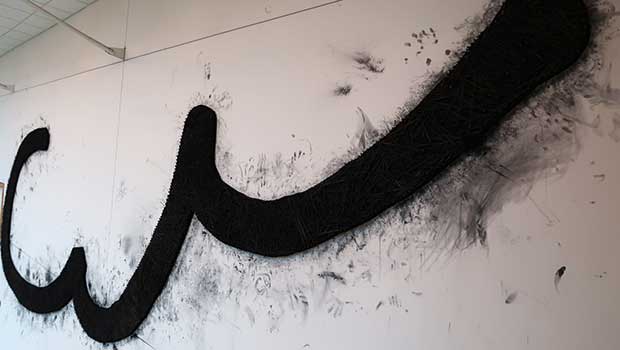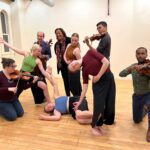
“The plunder of black life was drilled into this country in its infancy and reinforced across its history,” writes Ta-Nehisi Coates in his 2015 book, “Between the World and Me,” a meditation on America’s still-virulent legacy of slavery that won the National Book Award for nonfiction.
Now, visible from outside the Rose Art Museum at Brandeis University in Waltham as well as indoors, a wall-size mural inspired by the book renders the word “plunder” in giant, curving strokes of Gregg shorthand, the stenographers’ tool that translates sounds into curving and bisecting lines. Both an abstract image to those who cannot read the stenographic script and also an exact rendering of the word, “Plunder” is the work of the acclaimed Chicago-based artist Tony Lewis.
If you go
What: “Plunder” by Tony Lewis
Where: Rose Museum at Brandeis University
411 South S., Waltham
Hours: Wednesday through Sunday 11 a.m.–
5 p.m. Free admission
For more information, visit: http://bit.ly/2AkGvcj
On view through June 10, 2018, the site-specific installation has iconic power with its sweeping curves and arabesque loops; it also rewards a close-up look, with its web-like structure of crisscrossing rubber bands and screws. Its black spirals ascend in parallel with a staircase that serves as both a frame and a viewing platform, allowing visitors to examine the mural at close range.
What they see are rubber bands — 19,000 of them — each dipped in graphite, the same mark-making mineral that powers pencils, and each fastened by screws drilled into the wall. The drilling, and all the other intensive manual labor that went into making the piece, echo the sentence from Coates as much as the word itself.
Known for spare, mural-scale drawings in black and white that distill words into abstract images, Lewis, 31, is the recipient of the museum’s 2017-2018 Ruth Ann and Nathan Perlmutter Artist-in-Residence Award. As part of his residency, Lewis created “Plunder” over five days in October with nine Brandeis undergraduates.
The work abounds in paradoxes. Although its subject is toxic — the human plunder of racism — it is elegant and exultant as an abstract form, evoking Japanese calligraphy or even, from a certain angle, the Nike Swoosh. The mural is both an abstraction and, to those who read Gregg shorthand, a word. And while employing a note-taking tool designed to cut labor and time, it is the product of a slow, painstaking process. The students’ graphite-stained handprints and smears surround the edges of the work like signatures.
In both the making of this mural and the end result, Lewis is slowing down time, unraveling the past, in collaboration with a group of young people. Similarly, in his text, which is addressed to his 15-year-old son, Coates looks at the nation’s past and present, unraveling the burden of slavery at its core.
Lewis is not alone in his endeavor to deconstruct the familiar and treat words as objects laden with history, liberating language from its implied certainties. He works within the tradition of such text-oriented conceptual artists as Glenn Ligon, 20 years his senior, whose stenciled canvases quote renowned authors and progressively blur the words beyond recognition.
Many black artists of Lewis’s generation, including authors, poets and visual artists, are examining how cultural conventions — the images we see and the words we say, read and hear — shape experiences, including the experience of racial identity.
Lewis also is among six prominent young African American artists taking part in a group show entitled “Speech/Acts,” at the Institute of Contemporary Art Philadelphia. Responding to experimental black poetry, they explore how language reinforces racial messages. By challenging the familiar, Lewis and his contemporaries are opening freighted cultural terrain to inquiry, loosening its grip.

![Banner [Virtual] Art Gallery](https://baystatebanner.com/wp-content/uploads/2024/04/NJ-H_1-150x150.jpg)


![Banner [Virtual] Art Gallery](https://baystatebanner.com/wp-content/uploads/2024/04/NJ-H_1-713x848.jpg)

